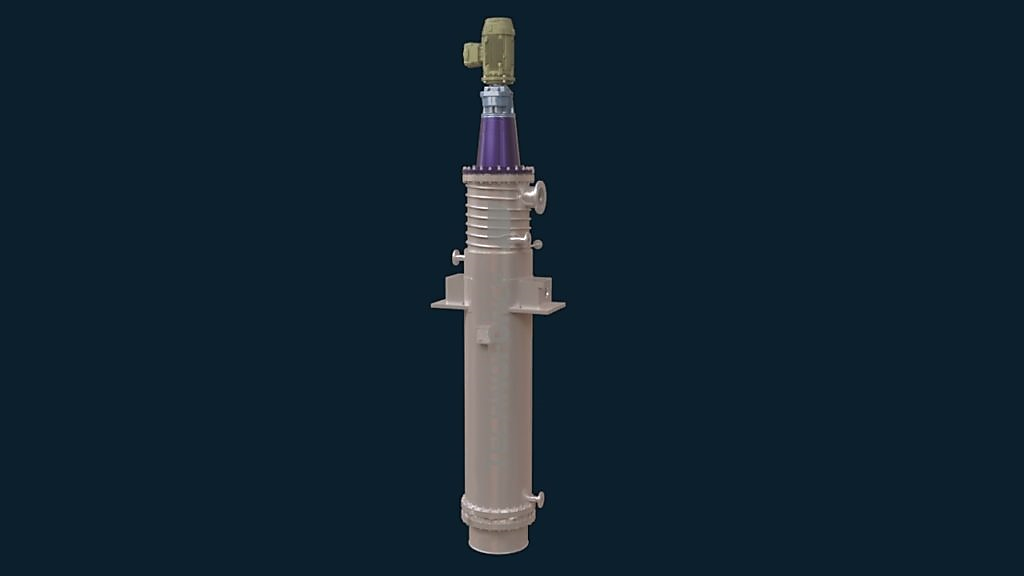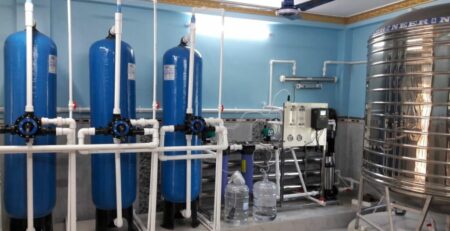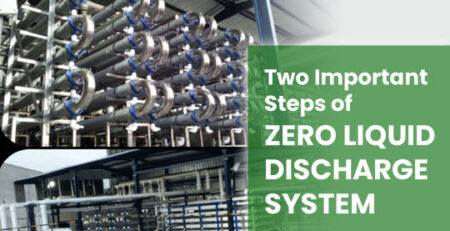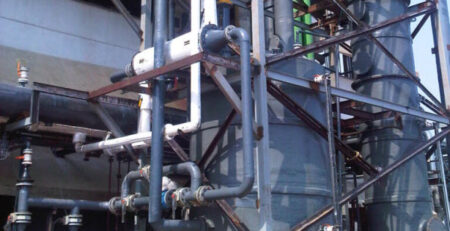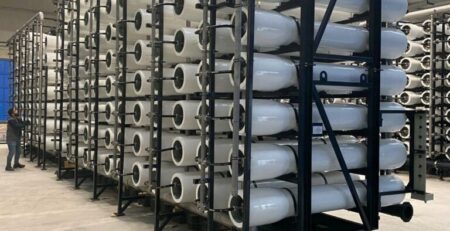Design, Operating Principles, Characteristics and Components of ATFD
Agitated thin-film dryers (ATFDs) are commonly in use to produce dry free-flowing powder from slurry/solution-type feed and are extensively applicable in pharmaceutical, chemical, food industries and metal industries.
Agitated Thin Film Dryer (ATFD) Overview
Agitated Thin Film Dryer ATFD design is ideal for thermal treatment of solutions and heat sensitive products, where vacuum operating pressures and reduced operating temperatures are required. The regular ATFD comprises a tubular transfer area with an external heating jacket and a fast-revolving, inner rotor with flexible or rigid elements. The operating speed is adapted to the product being handled, its specific requirements and task.
As agitated thin film dryer manufacturer, the feed product is uniformly distributed by the rotor and a thin film of uniform thickness is formed by the wipers over the heating surface. At the tip of the rotor blades, highly turbulent swirls are produced and wipers with rapid mixing and agitation of the product, when meeting the heating surface. This ensures exceptional heat transfer combined with constant regeneration of the product film and gives uniform heating and short residence time of the product via the how to get rid of water retention while on testosterone heated zone.
A Properly Designed ATFD
- Be designed to efficiently transfer the heat at a high rate with reduced surface area to be cost-effective for installation, operations and maintenance.
- Efficiently separate the vapours from the liquid concentrate to meet the required conditions by the product being processed.
- Produce the required quality product.
- For making it energy efficient, where desired making effective use of steam with multiple effect evaporation or vapor recompression.
- Reduction in the fouling of heat transfer surfaces.
- Use construction materials that are adequate to minimize
Operating principles of ATFD
ATFD works for the evaporation of water/solvents to make concentrated liquid to dry powder or flakes.
As ATFD manufacturer, it is an ideal apparatus used for the continuous processing of concentrated material to dry solids. It consists of a cylindrical, vertical body with a heating jacket and rotor inside of the shell, equipped with rows and pendulum blades all over the length of the dryer. The wet feed product is spread by the hinged blade in a thin film over the heated wall.
Horizontal orientation is needed when the feed is in the thick slurry form, paste or wet powder. The fixed clearance rotor with screw elements inhibits scale formation and conveys the material from the feed end to the powder discharge end in a continuous manner.
Components of ATFD:
- Cyclone separator
- Feed distributor
- Cylindrical shell containing shaft and blades
- Hinged (immovable) blades
- Scrapper (moveable blades)
- Motor and mechanical seal
- Gear box
- Powder collection area
 Critical operational and Product Characteristics of ATFD
Critical operational and Product Characteristics of ATFD
1. Heat Sensitivity
Many industries like food, pharmaceuticals, chemicals are temperature sensitive and require low heating temperature and short residence time exposed to heat. This can be accomplished by a combination of reducing the volume of product in the evaporator at any time, minimizing the time in the evaporator and reducing the products bulk boiling temperature by operating the evaporator at minimized pressures. By reducing the internal operating pressure may also allow operation at reduced heating temperatures, maintaining a suitable heat- transfer driving force (the difference of temperature between the boiling point of the bulk product and the temperature of the agitated medium)
2. Fouling
Fouling of the heat transfer surfaces is generally caused by solids in the feed, evaporating solids in the concentrate, or deterioration of the product. A slow formation of a film on the heat transfer surfaces will cause a slow reduction in the overall heat transfer coefficient. Ultimately it will require shutdown of the process and cleaning of the heat transfer surfaces, resulting in production downtime and additional maintenance labour.
3. Foaming
Foaming of products during vaporization is common. It may range from a small amount of unstable foam that breaks easily to a stable foam which is difficult to break and tends to fill the whole void of the evaporator system. It can be reduced by special designs for the feed inlet and the vapor/liquid separation area. Reducing the boiling intensity of the liquid on the heat transfer surface and reducing the vapor velocity in the tubes may significantly lower foaming. Where the product purity specifications allow, application of antifoam may solve or minimize the incoming problem.
4. Solids
The properties of the concentrate vary with the increase in concentration of solid. Solids may plug tubes, causing loss of heat transfer surface, in turn resulting in reduced heat transfer rates and requirement of downtime for cleaning. Solids enhance the tendency to foul the heating surface, which further minimizes the heat transfer coefficient boil-up rate. Increase in solids may also increase the concentrate viscosity, which affects overall heat transfer coefficient, reducing capacity.
5. Viscosity
Increase the viscosity of the concentrate, decrease it will be the overall heat transfer coefficient.
6. Heat Transfer Medium
Selection of the type of evaporator depends on the heat transfer medium (oil or steam). Liquid heated evaporators generally have lower overall heat transfer coefficients and need more heat transfer area. If the product is thermally stable, then hot oil heating may allow higher temperatures and overcome the lower heat transfer coefficients. This leads to the use of small evaporators in some cases.
How does Agitated Thin Film Dryer (ATFD) work?
ATFD is fed from top and the product desired is collected at bottom under vacuum application as described in the following steps:
- Vacuum: It is necessary to maintain maximum possible vacuum in the system
- Heating: Jacket shell is required to be pre- heated
- Feeding: in the system, feed is required to be pumped consistently based on the flow rate and it must be distributed uniformly through a distributor which is placed above the shaft.
- Film formation: The feed will meet the hinged blades attached to the shaft; the high RPM blades shall splurge the feed onto the surface. The splurged feed will form a film over the surface of the cylinder and due to gravitational pull, film will slide over the cylindrical vessel.
- Heat transfer and Vaporization: the energy is transferred by the heated surface to the falling film and as it slides over the heat transfer area, the volatile matter will be vaporized and from point to point the volatile components decrease.
- Powder collection: The dried content then collected in the bottom section of the ATFD.
 Application of Agitated Thin Film Dryer (ATFD) in different industries
Application of Agitated Thin Film Dryer (ATFD) in different industries
- Pharma Industries
- Agro Chemical Industries
- Food and Beverage Industries
- Sugar Industries and Effluent Treatment Plant
- Metal Industries
- Pulp and Paper Industries
- Polymers and Resins Industries
Features and Advantages of ATFD
- Well suited for Heat sensitive products due to low residence time of a few seconds.
- It can be used as a Vacuum Dryer for reduced temperature, pressure as low as 1 mbar.
- Indirect heating.
- Effective for oxygen sensitive products.
- Air free Operation.
- Full recovery of organic solvents.
- Dust free powder of comparatively higher bulk density.
- Powder of uniform consistency
Use of ATFD in wastewater treatment, zero liquid discharge system
As agitated thin film dryer supplier, the ATFD finds its major application in wastewater treatment associated with Zero Liquid Discharge System (ZLD).
In ZLD systems, effluents generated from several sources are collected in high concentration streams HCS and low concentration streams LCS collection tanks for wastewater recovery. Wastewater collected in HCS collection tanks is fed to the solvent stripper, where mixed solvents are stripped and collected in the top distillation tank. Stripper processed effluent gathered from stripper column bottom fed to multiple effect evaporator MEE, where maximum liquid is extracted, and condensate collected to the condensate collection tank. The concentrate collected from MEE and ATFD then goes to collection tanks and salts produced are disposed of to TSDF (Transport Storage Disposal Facility). The condensates then transfer to low concentration wastewater collection tanks for further treatment.
 Let’s have an example of Zero Liquid Discharge Industrial Wastewater treatment following ATFD and other processes in the pipeline.
Let’s have an example of Zero Liquid Discharge Industrial Wastewater treatment following ATFD and other processes in the pipeline.
Many chemical, pharmaceutical, electrochemical, electronics, petrochemical and food processing industries generate wastewater. Pharmaceutical industrial wastewater has low TDS and high TDS water. In low TDS water, TDS is less than 5000 ppm and in high TDS water, it is higher than 5000 ppm. Water with low TDS is supposed to treat primary- secondary- tertiary treatments. High TDS water is supposed to be treated primarily and sent to stripping column MEE- ATFD to treat it further to low TDS water. The RO feed tank receives the permit from the tertiary treatment. The feed from RO plant is then sent to a high TDS feed tank and the permit from RO plant is reused in a boiler.
Working Procedure of Stripper Column
Start the cooling water and treated effluent transfer pumps, then feed the stripping column at a consistent rate. In the kettle after reaching 70% level, stop the feed pump. Adjust the steam value (steam pressure should be 1.0-1.5 kg/cm²) to the reboiler and sewers the condensate water by opening the bypass valve. After termination of the condensate water, close the condensate bypass valve. Add the top condensate in the collection receiver. On the feed pump and keep the required feed rate by regulating the flow meter. Start the stripper bottom pump and transfer the bottom with needed flow rate. Collect the condensate in the receiver up to 50% of the mentioned level. Start the reflux and collection pump. Keep 75% flow rate as reflux and 25% as collection. Maintain the kettle and top vapor temperature around 105±20C and 85±50C respectively.
Working Procedure of Multiple Effect Evaporator
Start cooling water pump, treated effluent feed pump and stock the effluent in the phase separator (PS-1) up to the 50% of the view glass. Start the recirculation and effluent pumps (1 and 2) and transfer the effluent from phase separator 1 to phase separator 2 and cover 50% of the view glass. Then start recirculation and ETP pump 3 and transfer effluent from PS 3 to PS 1 and maintained 50% of the glass view. Then recirculation of effluent is done by maintaining levels in the PSs and vacuum pump maintained at 600-650mmHg. Open the steam valve and maintain a steam pressure of 1.5-2.0 kg/cm2 and a temperature of 850 degrees Fahrenheit. Collect the vapor condensate in the collection receiver and feed the effluent synchronously. The MEE concentration, mass and vapor condensate samples are then sent to the ETP lab for analysis. When the MEE concentration mass is reached 2 lac ppm, collect the concentrated mass to the storage tank. Start the pump to transfer the condensate H2O to LTDS neutralization tank. Stop the recirculation pumps.
Working Procedure of Agitated Thin Film Dryer (ATFD)
Start the cooling water pump and interlock switch in “ON ” position. To the top and bottom jacket of the dryer open the steam and drain the condensate water by opening the by-pass valve, then close the condensate by-pass valve after removing condensate water. On the air blower then the agitator. Start the feed rate 300-500 l/hr. to the dryer when the vapor temperature reaches 950C. Collect the vapor condensate in the low TDS collection tank using a pump. Do Check the pH, TDS of vapor condensate and water content in the solid waste collected at the bottom and record it. Collect and transfer the solid material to the hazardous waste storage shed.
Operating Procedure of Reverse Osmosis Plant
Treated effluent is collected in the storage tank for advanced treatment. Send the sample to the lab for checking of pH, TDS, COD and TSS to fulfil the operating properties of the RO plant feed. Regulate and maintain the pH of the effluent to 6.5 prior to feed in the system. Wipe filter cloths and cartridges before starting the system. When pressure increases gradually the effluent separates as it permeates and rejects. Permeates and rejects are collected in respective tanks. Then it is sent to the lab to meet the output specifications. Otherwise send the permeate water to the RO feed plant for further treatment and record the analysis.
Results
- Condensate from MEE- ATFD and utilities are collected on daily basis, analyzed and various methods are applicable on it to reduce organic content of effluent waste which reduce COD of the effluent up to 80-90%.
- Contributes to better Environmental conditions which can be easily maintained and economical.
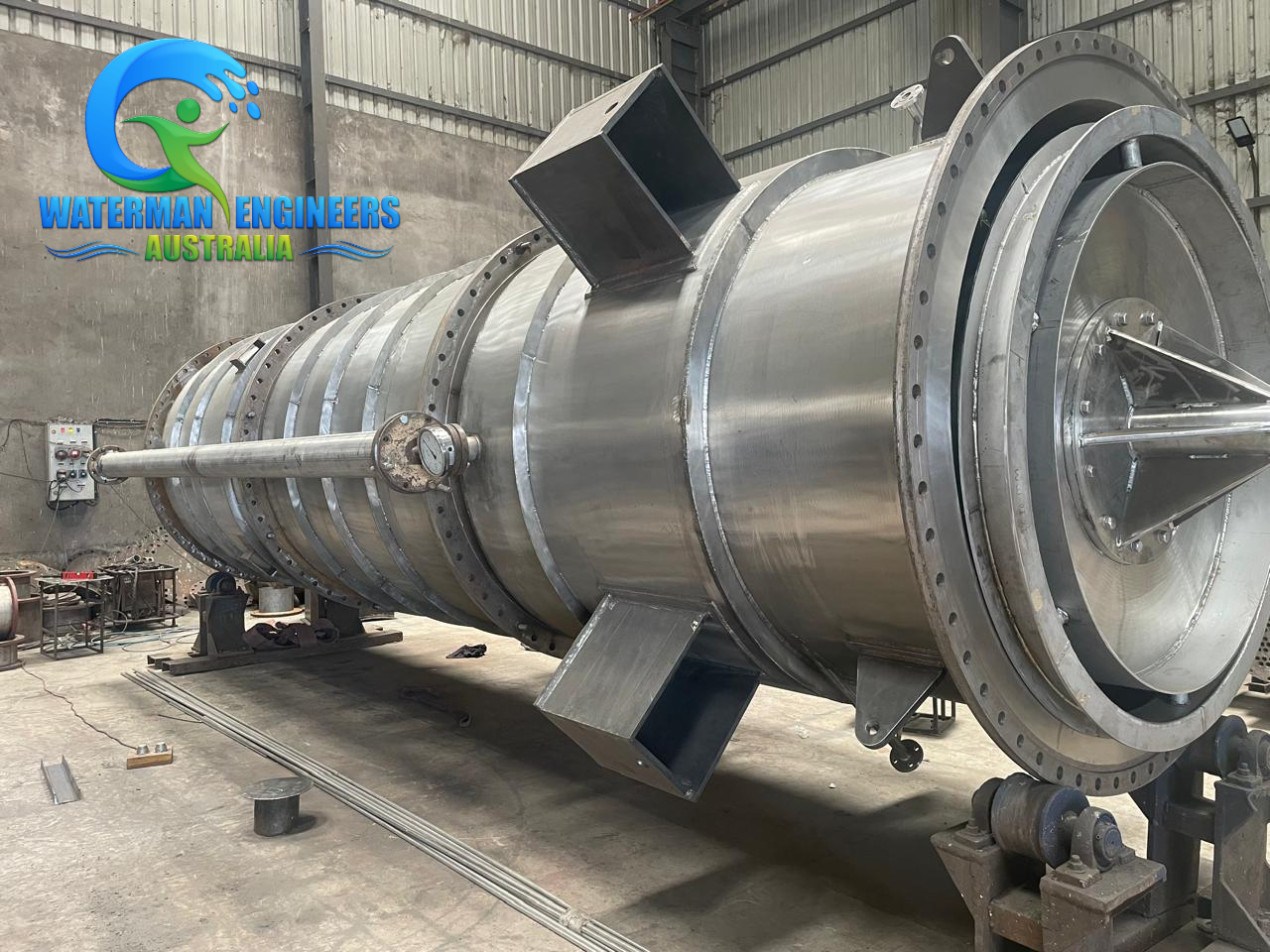 Agitated Thin Film Dryer Frequently Asked Questions
Agitated Thin Film Dryer Frequently Asked Questions
1) What is Agitated Thin Film Dryer equipment?
The Agitated Thin Film Dryer is the perfect tool for turning concentrated material continuously into dry solids. The apparatus has a vertical, cylindrical body that is coated with a heating jacket. A row of pendulum blades installed within spread the wet feed product as a thin film.
2) What is Agitated Thin Film Dryer in water treatment?
Agitated Thin Film Dryers use concentrated liquid created by the evaporation of water and solvents to dry powder or flakes. The appropriate tool for drying solids in a continuous operation using concentrated material is an agitated thin film dryer.
3) What are the components of Agitated Thin Film Dryer?
- Cyclone separator
- Motor and mechanical seal
- Gear box
- Powder collection area
- Feed distributor
- Cylindrical shell containing shaft and blades
- Hinged (immovable) blades
- Scrapper (moveable blades)
4) What is a zero liquid discharge system?
A strategic wastewater management method called zero liquid discharge (ZLD) makes sure that no industrial effluent will be released into the environment. It is accomplished by first recycling wastewater, followed by recovery and reuse for industrial purposes.
5) Why is zero liquid discharge important?
A water treatment method called Zero Liquid Discharge (ZLD) aims to eliminate all liquid waste from a system. ZLD focuses on producing clean water that may be used again (for example, irrigation), reducing wastewater in an inexpensive manner, and protecting the environment.

